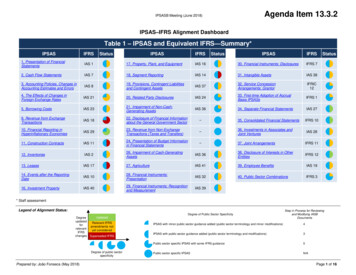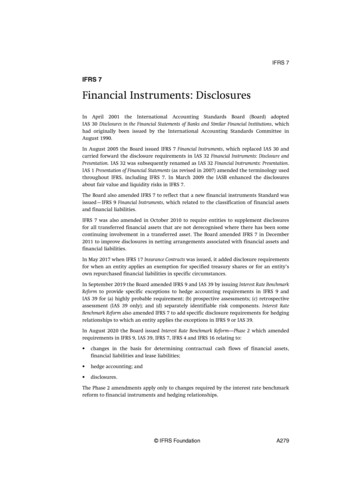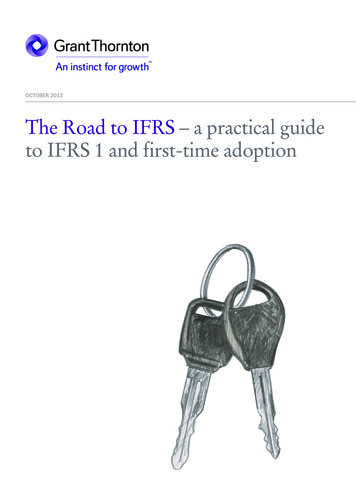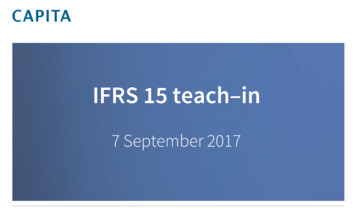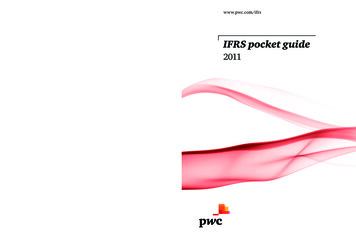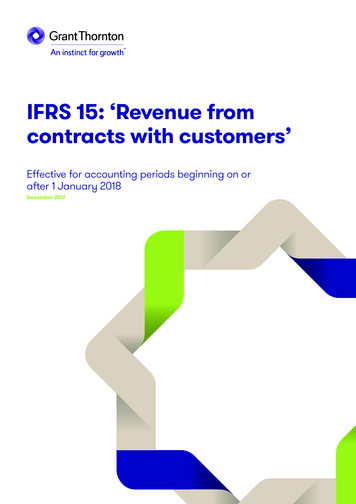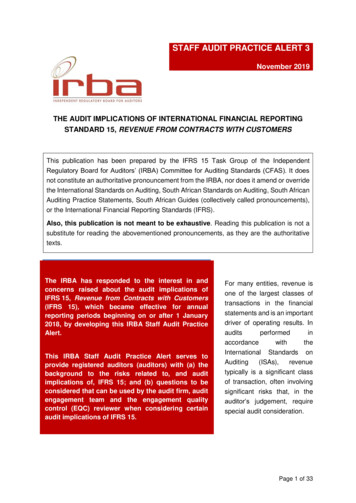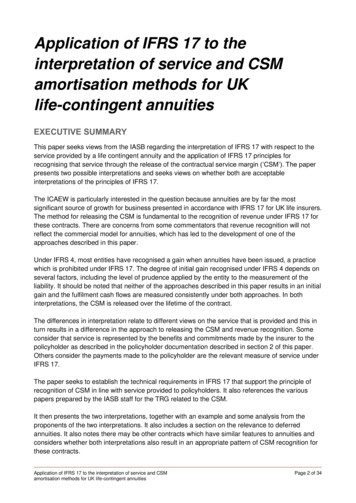
Transcription
Application of IFRS 17 to theinterpretation of service and CSMamortisation methods for UKlife-contingent annuitiesEXECUTIVE SUMMARYThis paper seeks views from the IASB regarding the interpretation of IFRS 17 with respect to theservice provided by a life contingent annuity and the application of IFRS 17 principles forrecognising that service through the release of the contractual service margin (‘CSM’). The paperpresents two possible interpretations and seeks views on whether both are acceptableinterpretations of the principles of IFRS 17.The ICAEW is particularly interested in the question because annuities are by far the mostsignificant source of growth for business presented in accordance with IFRS 17 for UK life insurers.The method for releasing the CSM is fundamental to the recognition of revenue under IFRS 17 forthese contracts. There are concerns from some commentators that revenue recognition will notreflect the commercial model for annuities, which has led to the development of one of theapproaches described in this paper.Under IFRS 4, most entities have recognised a gain when annuities have been issued, a practicewhich is prohibited under IFRS 17. The degree of initial gain recognised under IFRS 4 depends onseveral factors, including the level of prudence applied by the entity to the measurement of theliability. It should be noted that neither of the approaches described in this paper results in an initialgain and the fulfilment cash flows are measured consistently under both approaches. In bothinterpretations, the CSM is released over the lifetime of the contract.The differences in interpretation relate to different views on the service that is provided and this inturn results in a difference in the approach to releasing the CSM and revenue recognition. Someconsider that service is represented by the benefits and commitments made by the insurer to thepolicyholder as described in the policyholder documentation described in section 2 of this paper.Others consider the payments made to the policyholder are the relevant measure of service underIFRS 17.The paper seeks to establish the technical requirements in IFRS 17 that support the principle ofrecognition of CSM in line with service provided to policyholders. It also references the variouspapers prepared by the IASB staff for the TRG related to the CSM.It then presents the two interpretations, together with an example and some analysis from theproponents of the two interpretations. It also includes a section on the relevance to deferredannuities. It also notes there may be other contracts which have similar features to annuities andconsiders whether both interpretations also result in an appropriate pattern of CSM recognition forthese contracts.Application of IFRS 17 to the interpretation of service and CSMamortisation methods for UK life-contingent annuitiesPage 2 of 34
1.THE UK ANNUITY MARKET AND WHY THIS ISSUE IS PREVALENTIN THE UKWithin the UK insurance market, annuity contracts, specifically the bulk purchase annuity market isthe main growth area for life insurance business within the scope of IFRS 17. Bulk purchaseannuities (BPAs) is the term used to refer to defined benefit pension schemes which are parcelledup and sold to large insurers to manage the risk such that the beneficiaries of the scheme receivetheir pension payments when they fall due for as long as they live. This enables UK employers withsignificant pension liabilities to pass the liability for paying pensions to insurers who will contract tomanage the risk on behalf of the trustees of the pension scheme. The fact that a BPA contracttransfers the risk associated with defined benefit pension scheme liabilities means there aretypically complex and varying terms with the contract, all of which are transferred to the insurer tomanage. This has a positive impact on UK economic growth as it enables businesses to de-risktheir balance sheet by passing the management of pension liabilities to the insurance industry andfocus on growing their business. Transactions during 2020 totalled c 30bn and are forecast toaverage over 40bn a year up to 2030. Almost 150bn has been written by eight marketparticipants over the period 2009 to mid-2020.Given the prevalence and the long duration of annuities, particularly BPAs where a typical annualcohort of contracts will take up to 70 years before all the profit is recognised, the CSM amortisationprofile significantly impacts the timing of profit recognition under IFRS 17.Below is a summary of estimated financial information on the size of the UK annuity market:Individual annuitiesThe individual annuity market is mature and in recent years has declined, due largely to pensionsfreedoms introduced by the 2014 Pensions Reform Act. For example, in a 2018 report, PwC notedthat new individual annuities sold in the UK declined by 78% between 2013 and 2016.Nevertheless, due to the size of the back book, this remains a major business. FCA informationshows that new business was provided by roughly 20 entities, though business is nowconcentrated in only five main insurance groups. Assets under management backing annuityliabilities amount to some 300 billion.Bulk purchase annuitiesBy contrast, the BPA business is increasing in significance and is the main growth area within theUK insurance market. BPA transactions amounted to 31.6bn in 2020, as reported by PensionAge,and Hymans Robertson report that almost 150bn BPA business has been written by eight marketparticipants in the period 2009 to 2020. Hymans Robertson forecast BPA transactions to averagearound 40bn per year up to 2030. Although declining after 2030, their forecast shows continuedhigh levels of BPA transactions up to 2040 (average over 20bn p.a.).The level of transactions is driven by pension schemes’ de-risking strategies and buy-outs resultingfrom sponsor insolvencies. Annuities are long term business, with typical duration of a singleannual cohort of immediate annuities being 40 years. For BPA cohorts which typically includedeferred annuities the duration of an annual cohort is typically 70 years. Average duration in theBPA market is longer, as members are typically younger and a significant proportion of livesinsured are in the deferred phase (ie, in the phase before retirement).Application of IFRS 17 to the interpretation of service and CSMamortisation methods for UK life-contingent annuitiesPage 3 of 34
Discussions by the UK Endorsement Board with standard setters in Canada and Australia and ourreview of EFRAG’s Final Endorsement Advice indicate that the allocation of CSM for annuities is aparticular UK concern. It was not a focus area for EFRAG and is not a significant topic of currentdebate in Canada or Australia, although we understand annuities are prevalent in those markets.These jurisdictions are seeing an increase in BPAs, though not on the scale observed in the UK.The service provided by a life contingent annuity contractSince pension freedom was introduced in the UK in 2015, individual policyholders are able tochoose from several options at retirement. All of them, except for annuities, are investment optionsthat could result in the policyholder running out of money if they live longer than expected. Theuncertain future event that creates insurance risk in an annuity contract is the uncertainty over howlong the policyholder will survive. The benefit of an annuity is that it provides a guaranteed incomefor life, however long that life is. Therefore, in opting for an annuity when alternative investmentoptions are available, the policyholder is choosing to buy protection against the uncertainty of howlong they will survive, ie, the benefit to the policyholder is longevity protection.A review of policyholder documentation and UK Financial Conduct Authority guidance sets out thekey terms of a life contingent annuity contract, which are: A promise to pay the policyholder a guaranteed income for the rest of their life; The choice to include payment of income to a dependent when the policyholder dies; The fact that this is a once-and-for-all decision for the individual policyholder regarding theirfuture income needs for the remainder of their life, subject to any guarantees1 (typically 5 or 10years) explicitly stated in the contract; There is no possibility to cancel or surrender the contract and there is no return of premium ondeath.Individual annuities and bulk purchase annuity contractsThe service provided by an individual annuity contract is consistent with the service provided bybulk purchase annuity contracts, where the policyholder is a pension scheme trustee that transfersthe whole or tranches of its pension liabilities to an insurer. The statement of facts provided to thepolicyholder states that the product is designed to de-risk a pension scheme by purchasing coverfor longevity, investment and inflation risk. ie, the benefit of the annuity to those trustees is layingoff the risks around investment, inflation and longevity that could otherwise impact their ability tomeet the future income stream obligation to their pensioners. The investment risk and inflation riskare both financial risks, it is the transfer of the longevity risk that makes annuity contracts insurancecontracts.Bulk purchase annuities may include a deferral of payments where they include pension schememembers who are yet to retire. The benefit to the trustees of insurance is present in this deferredphase and will also reflect options the policyholder has in terms of how benefits will be realised (eg,transfer out / lump sum benefits etc).1Contracts may contain a feature that will pay out a fixed amount if the policyholder dies during a specifiedperiod at the start of the pay-out phase.Application of IFRS 17 to the interpretation of service and CSMamortisation methods for UK life-contingent annuitiesPage 4 of 34
2.TECHNICAL REQUIREMENTS OF IFRS 17Under IFRS 17, an amount of the CSM for a group of insurance contracts is recognised in profit orloss in each period to reflect the profit earned for insurance contract services provided under thegroup of insurance contracts in that period. The amount is determined by reference to thecoverage units in the group, which are defined as ‘the quantity of insurance contract servicesprovided by the contracts in the group, determined by considering for each contract the quantity ofthe benefits provided under a contract and its expected coverage period’.The appendix provides more information about how the CSM is recognised in profit or loss,including relevant references from the standard, the basis for conclusions and TRG papers.Application of IFRS 17 to the interpretation of service and CSMamortisation methods for UK life-contingent annuitiesPage 5 of 34
3.IMPLEMENTATION QUESTION AND ANALYSIS OF APPROACHESBackgroundThe method for releasing the CSM for annuities has been a key question In the UK market, giventheir importance to insurers issuing these contracts. This included considering the deferred phaseprior to the issue of the amendments to the standard in June 2020, which included changes relatedto the recognition of an investment return service and the inclusion of expenses incurred toenhance benefits.The ICAEW has also been considering the application of IFRS 17 in the context of life-contingentimmediate annuity contracts. Two views have developed regarding the interpretation of theservices provided in each period to the policyholder and the resulting approach to release the CSMto reflect the service provided.The first method of CSM allocation, presented as Approach A in this paper, is consistent with theIASB staff comments provided in example 12 in the agenda paper 5 of the May 2018 TRGmeeting. The second method, presented as Approach B in this paper, was not considered inexample 12 and hence we would like to obtain more clarity as to whether it also represents apermissible interpretation of the principles of IFRS 17.Implementation questionAre both Approach A and Approach B permissible interpretations of IFRS 17 to support theprinciple in IFRS 17 to release the CSM in line with the service provided to the policyholder?Fact patternThe following fact pattern and example forms the basis of the analysis of the two approaches.A life-contingent immediate annuity contract is issued at the beginning of Year 1 that pays out afixed periodic (annual) benefit of currency units (CU) 1,000 each year until the annuitant dies.Key characteristics of the contract which are relevant for the analysis are: The contract provides the policyholder with a guaranteed income for life. Payment of the premium is a once and for all decision, after the cooling off period of 90 days there is no opportunity for the policyholder to seek any refund of premium. On death of the policyholder all payments cease, and the insurer has no further obligationunder the contract including to return any premium. The periodic annuity benefit payments are made annually in advance; if the policyholder diespart way through a period there will be no attempt to recover any portion of the last paymentmade. Inflation is ignored, for simplicity. The contract provides an immediate annuity, so there is no deferral or accumulation periodbefore the annuity starts. The amount of the annuity payments is determined based on theamount of premium paid. There is no guarantee period where the policyholder’s dependants would continue to receiveincome from the annuity even if the policyholder dies. The contract can provide other services e.g., death benefit, protection for spouses anddependents, but these are ignored for simplicity.Application of IFRS 17 to the interpretation of service and CSMamortisation methods for UK life-contingent annuitiesPage 6 of 34
Analysis of viewsApproach A – The CSM allocation is determined based on the periodic benefit payable ineach period that services are provided.Under this method, the periodic benefit payable represents the quantity of benefits provided underthe contract for each discrete insured event (policyholder’s survival to the point of payment of aclaim) and reflects both the maximum amount that a policyholder could validly claim in each periodif an insured event occurs and the maximum contractual cover in each period.Proponents of this approach believe that an annuity contract has a series of insured events, beingsurvival to future points in time that valid claims can be made by the policyholder under thecontract. A key feature of the contract is that the policyholder needs to remain alive up to eachpoint in time in order to claim from the insurer the contractually agreed annuity payment (e.g.,survive in year 1 to receive the annuity payment at the start of year 2, the same for year 2 and soon for the duration of the policyholder’s life). Consequently, the insurance coverage and the serviceprovided to the policyholder in each period is represented by the periodic payments that thepolicyholder receives for surviving each period. These periodic annuity payments are consistentwith the notion of the maximum amount that a policyholder could validly claim in each period if aninsured event occurs and the maximum contractual cover in each period because the policyholderwould not have access to any other amounts in the period that the insured event occurred beyondthe periodic annuity pay-out.The interpretation that the periodic annuity benefit payable represents an acceptable method todetermine the quantity of services provided in each period for a life-contingent annuity contract wassupported by the IASB Staff view reported in example 12 in the May 2018 TRG paper (AgendaPaper 05, par.B46(b)).Example 1 – Illustration of Approach AThe application of the CSM allocation approach under Approach A can be illustrated in thefollowing example. Consider an annuity with an annual benefit of CU1,000 in a group with anexpected duration of 40 years. The probability of survival for each period is depicted in the tablesbelow (and in more details in the spreadsheet attached in the appendix) and the discount rate is3% for the whole duration. CSM is assumed to be CU100 at initial recognition which is the start ofyear 1. In both example 1 and 2, the coverage units are discounted for the time value of money.Approach A - Periodic benefit payable methodYear(s)1123456-1011-1516-2021-3031-40Annual 00010,000Discount %62.8%34.6%5.9%PV of Annual talInterest accretion3.02.92.82.62.510.87.85.13.90.442CSM 4.1-4.1-142Closing ty of(A) Current service(B) Current futureserviceCSM amortisation factor[(A)/(B)]4Opening CSMApplication of IFRS 17 to the interpretation of service and CSMamortisation methods for UK life-contingent annuitiesPage 7 of 34
Notes:1Information for years 6-20 is presented in buckets of 5 years. Information for years 21-40 is presented in buckets of 10 years as thefinancial impact of the CSM amortisation considerably reduces in the second half of the annuity pay-out period.2The discount factor from year 6 onwards reflects the average discount factor for the respective periods.3The probability of survival from year 6 onwards reflects average probability for the respective periods.4The CSM amortisation factor from year 6 onwards reflects the average CSM amortisation factor for the respective periods.5The CSM amortisation for the year buckets presented after Year 5 reflects the sum of the CSM amortisation for each year within the periodband applying the CSM amortisation factor in each respective year.The example does not show the risk adjustment or premiums for simplicity.Following the requirements in IFRS 17 B119 paras a) to c):1. Identifying the coverage units. In this example, the quantity of insurance contract services is14,786, which is the expected value of the amount to be paid to policyholders of the group overits duration. It is the present value of the annual payments of 1,000 per year for 40 years,adjusted for expected deaths each period. This equates to coverage units of 14,786 also.2. Allocate the CSM at the end of the period equally to each coverage unit provided in the currentperiod and expected to be provided in the future. So, for period 1, 990 coverage units areprovided (being the annual payment of 1,000 adjusted for expected survival in the period of99%) in the period and there are 13,786 left to be provided.3. Recognise in P&L, the amount allocated to coverage units in the period. So, for period 1, theCSM amortisation is 990 divided by 14,786 multiplied by 103 (being the starting CSM withinterest accreted for one year at 3%) 6.9.This method equates the quantity of insurance contract services in the accounting period to theamounts that are paid in the period. Thus, the quantity of benefits agrees to the present value ofthe total expected amount that will be paid to the policyholders in the group of contracts. Thismethod is consistent with the concepts that coverage units are linked to the maximum amountpayable in the period (that is 1,000 multiplied by the probability of survival in the example above)and the amount that may be claimed in the period (again being 1,000 multiplied by the probabilityof survival).The above method of CSM amortisation is consistent with how proponents of Approach A perceivethe service delivered in each period under the contract, which is considered to reflect a series ofinsured events and coverage for each insured event is provided in each period in which a validclaim can be made. Hence linking the coverage units to the payments is consistent with thetransfer of services in the period being equivalent to the annuity payments the policyholderreceives.The quantity of benefits (and the coverage units) for each contract is the sum of the annuitypayments that are expected to be paid to the policyholder. A consequence of this method is thatthe amount of CSM amortised in a period equates to the proportion of the total payments that isreceived by the policyholders in that period, after allowing for the probability of survival.This approach is believed to be consistent with the IASB Staff Approach As presented in Example12 in the May 2018 TRG paper.Proponents of Approach B believe this interpretation is consequential of how the proponents ofApproach A perceive the insured event and the emergence of service as a series of discreteApplication of IFRS 17 to the interpretation of service and CSMamortisation methods for UK life-contingent annuitiesPage 8 of 34
insured events and coverages as opposed to the survival risk being continuous throughout thecontract. They would therefore argue that Approach A attributes no benefits to insured eventswhich enhance the expected total lifetime benefits to the policyholder in periods that do not triggeran immediate payment. This element of service has commercial substance to the policyholder andreflects the stand-ready obligation from the insurer to the policyholder throughout the coverageperiod.They believe the interpretation under Approach A fails to recognise the fact that the policyholderhas exchanged premiums for insurance against the risk of surviving for an unexpected period oftime and the value the policyholder continues to obtain from the contract as long as thepolicyholder lives is continued insurance against the risk of their savings pot not lasting duringretirementThey believe there is commercial substance in this service and that this service is clearly perceivedby the policyholder by the continued access to the future stream of annuity payments that wouldcover the survival risk over their lifetime. The periodic annuity benefit fails to accurately capturethat transfer of service in the form of continuous insurance coverage to the policyholder for as longas they survive their contract.Approach B – The service in a period is based on the value to the policyholder of survivingto the end of the period which includes both the annuity payment in the period as well asthe continued access to receive a continuous stream of future payments for as long as thepolicyholder survives aligned to the description within policyholder documentation as setout in section 2.This reflects the insured risk under the contract (i.e. the risk of living longer than expected or longerthan the policyholder’s savings lasts and the policyholder having insufficient funds to cover theirliving costs for the remainder of their life).The CSM allocation is determined based on a quantity ofbenefits that is represented by the present value of all future payments under the contract and isconsistent with the method based on expected cash flows noted in the May 2018 TRG meeting.Proponents of Approach B believe that the policyholder is seeking to achieve financial security forthe remainder of their life.The development of Approach B has arisen as financial analysis of the impact of IFRS 17 hasdeveloped through the implementation process and identified that CSM allocation based onApproach A results in a very significant deferral of CSM recognition that is not evident from simpleexamples. In particular the simpler Approach A (based on annuity payments each period) does notreflect the key service which differentiates a life contingent annuity (the promise to pay for anuncertain period until the policyholder’s death) from a fixed term annuity (the promise to pay for afixed period). This does not reflect the commercial substance as market evidence supports the factthat policyholders pay an additional amount for the life contingent service.Application of Approach B aligns to the commercial substance observed in the UK’s market forannuity contracts which is directly linked to how market participants price annuities. If the CSMrelease profile is derived in a way which is not aligned with these economic principles, then overtime the amount of CSM diverges from that which would be measured based on market values (asobserved in the active BPA market) or new customer pricing principles. For example, if we assume2 customers aged 75 with otherwise identical risk profiles and all other assumptions are consistent,Application of IFRS 17 to the interpretation of service and CSMamortisation methods for UK life-contingent annuitiesPage 9 of 34
then compare the present value of CSM if one took out the policy 10 years ago, amortisedaccording to approach A, with the CSM for the other who takes out a new contract aged 75, theCSM post amortisation would be significantly greater for the existing customer than for the newcustomer. If alternatively, we use approach B then the CSM of the existing and new customers arealigned. Proponents of Approach B believe that the cash flow-based Approach A is notrepresentative of economics and would result in a material overstatement of the CSM for manydecades. It would generate a material divergence between the commercial substance of annuitybusiness written and what is reflected in the IFRS 17 balance sheet.Proponents of Approach B believe that the insurance contract service provided to the policyholderover the life of the contract is a guaranteed income (stream of payments) until their death. Theservice transferred in each period reflects survival in the period plus the entitlement to ongoingcoverage for survival in future periods for the expected duration of the policyholder’s life. Thebenefit provided to the policyholder is the continued right to receive payments this period and infuture periods until death as a result of the insured event which is survival.Therefore, proponents of Approach B think that the amount that can be validly claimed in theperiod represents part payment of an overall uncertain future claim and so an approach that viewsthe maximum contractual cover in a period, eg, an annual period, as one year’s worth of the sum ofthe payments the policyholder can expect to receive over the term of the contract (ie, the expectedduration until their death) better reflects the services provided in the period. This approach was notconsidered by the TRG during its discussions in May 2018, however it is consistent with themethod described in the May 2018 IASB TRG meeting summary paragraph 35 (h)(v):‘(v) methods based on expected cash flows. However, methods that result in no allocation ofthe contractual service margin to periods in which the entity is standing ready to meet validclaims do not meet the objective.’In contrast with Approach A, proponents of Approach B see the insured event as continuousthroughout the contract rather than a series of discrete, independent insured events and so in theirview the coverage period and service delivery is continuous spanning from the first period thepolicyholder is entitled to start receiving payments and ends on death of the policyholder when theinsurer’s obligations cease.Proponents of Approach B believe the definition of service in this approach is consistent with thetechnical requirements of IFRS 17.B119, the definition of insurance contract services and coverageperiod in appendix A as well as IFRS 17.BC222, because in their view the policyholder continuesto receive ongoing coverage in the period for the insured event under the contract, their survival,for the current and future periods for as long as they may live.Applying the definitions of insurance contract services and insured event in Appendix A of IFRS 17,the insurer in a life-contingent annuity contract in its pay-out period provides insurance coveragefor an ins
recognition of CSM in line with service provided to policyholders. It also references the various papers prepared by the IASB staff for the TRG related to the CSM. It then presents the two interpretations, together with an example and some analysis from the proponents of the two interpretations. It also includes a section on the relevance to .

